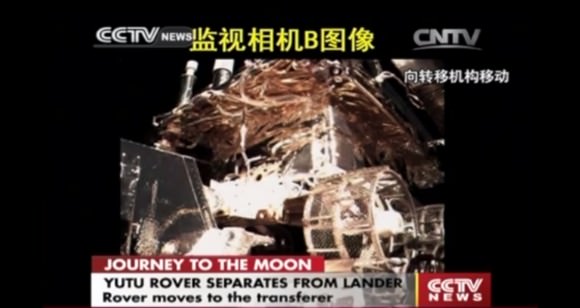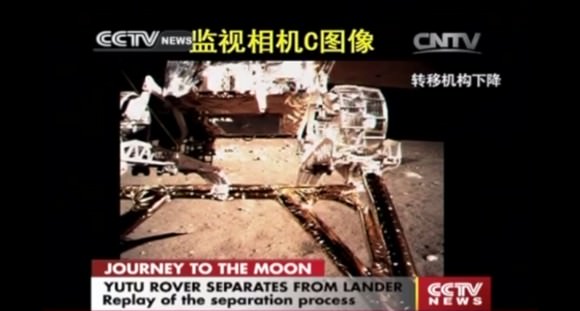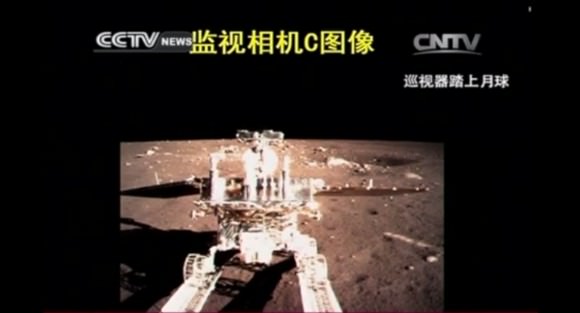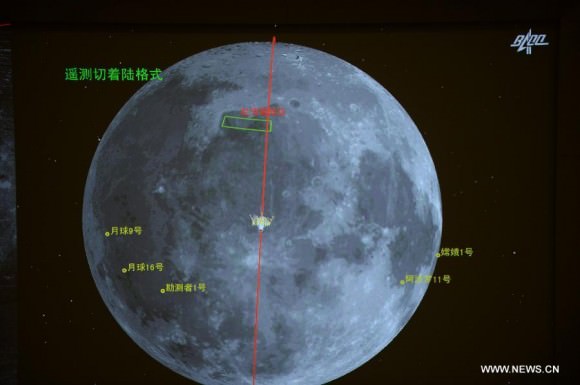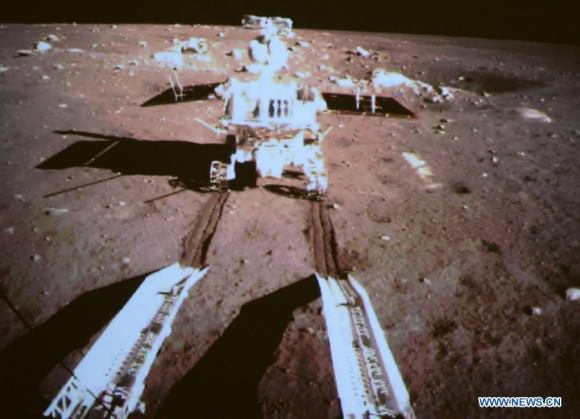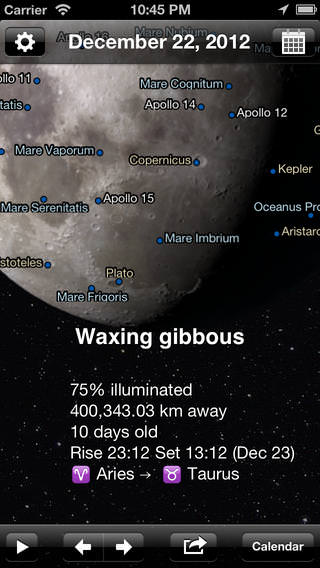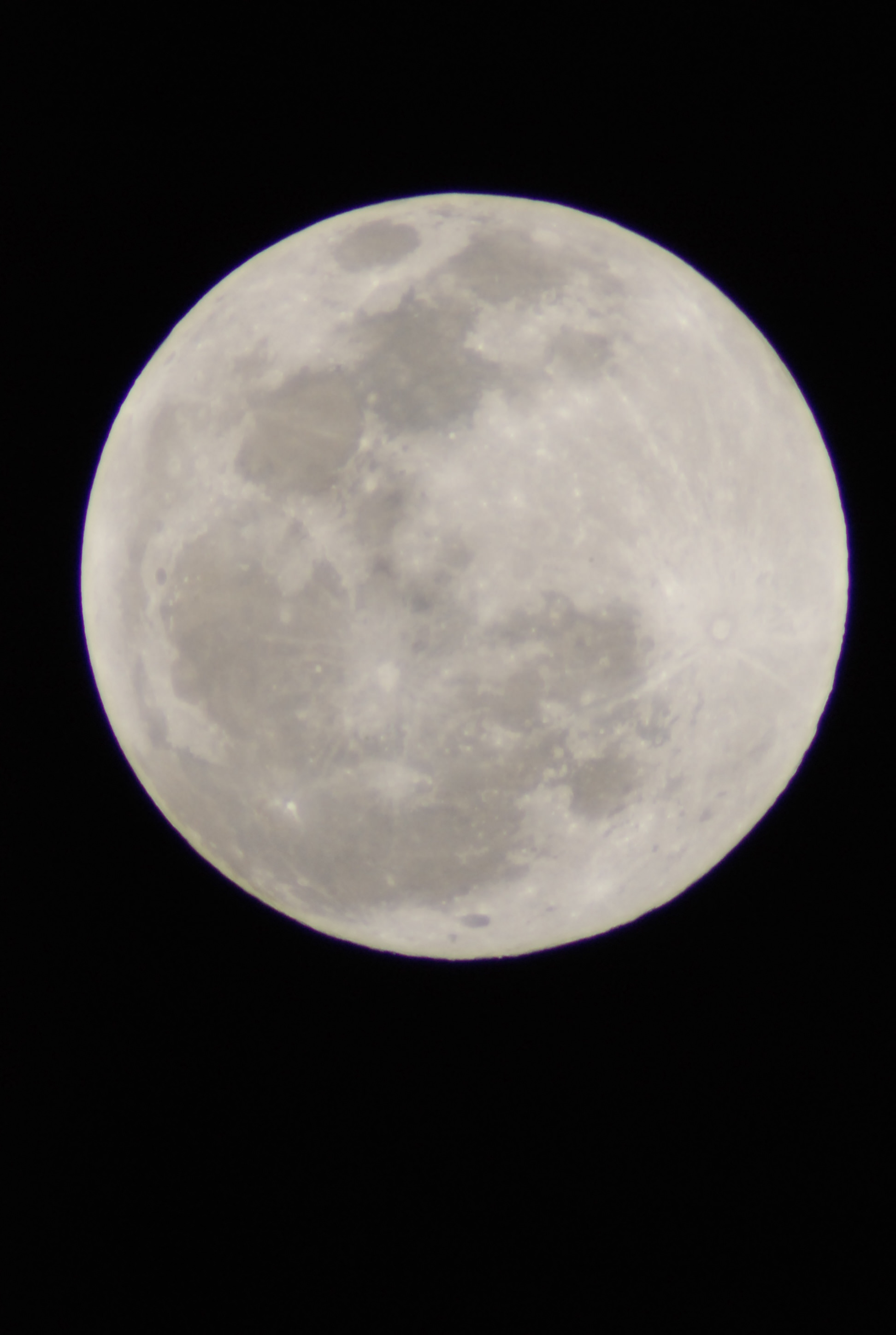When you consider the hazards of spaceflight, it’s hard to get worked up about dust bunnies. And yet, atmospheric dust is going to be one of the biggest problems astronauts will face when they reach the surface of other worlds. Where does this dust come from, and what does it tell us about the history of other worlds, and what can we do to mitigate the health risks?
Continue reading “Astronomy Cast Ep. 326: Atmospheric Dust”
Our Phases of the Moon App is Free Today – December 16, 2013
If you’re an iPhone/iPad user, you might be interested to know that we’re giving away our Phases of the Moon app away for free today. That’s a $1.99 app, totally free.
Based on the amazing simulated lunar phases by NASA’s Goddard Spaceflight Center, this app allows you to spin through the phases of the Moon on your phone or tablet. You can pinch zoom to see a full lunar atlas, or pan the Moon. See what the phase of the Moon was on your birthday or some special event.
If you do install it, could you take a second and write a review? It would really help us out.
P.S. The Android edition has always been free, and honestly it’s better because of the sweet Live Wallpaper and Widget.
Oh, the Places We’ve Been: 21 Spacecraft Trajectories Plotted in One Picture
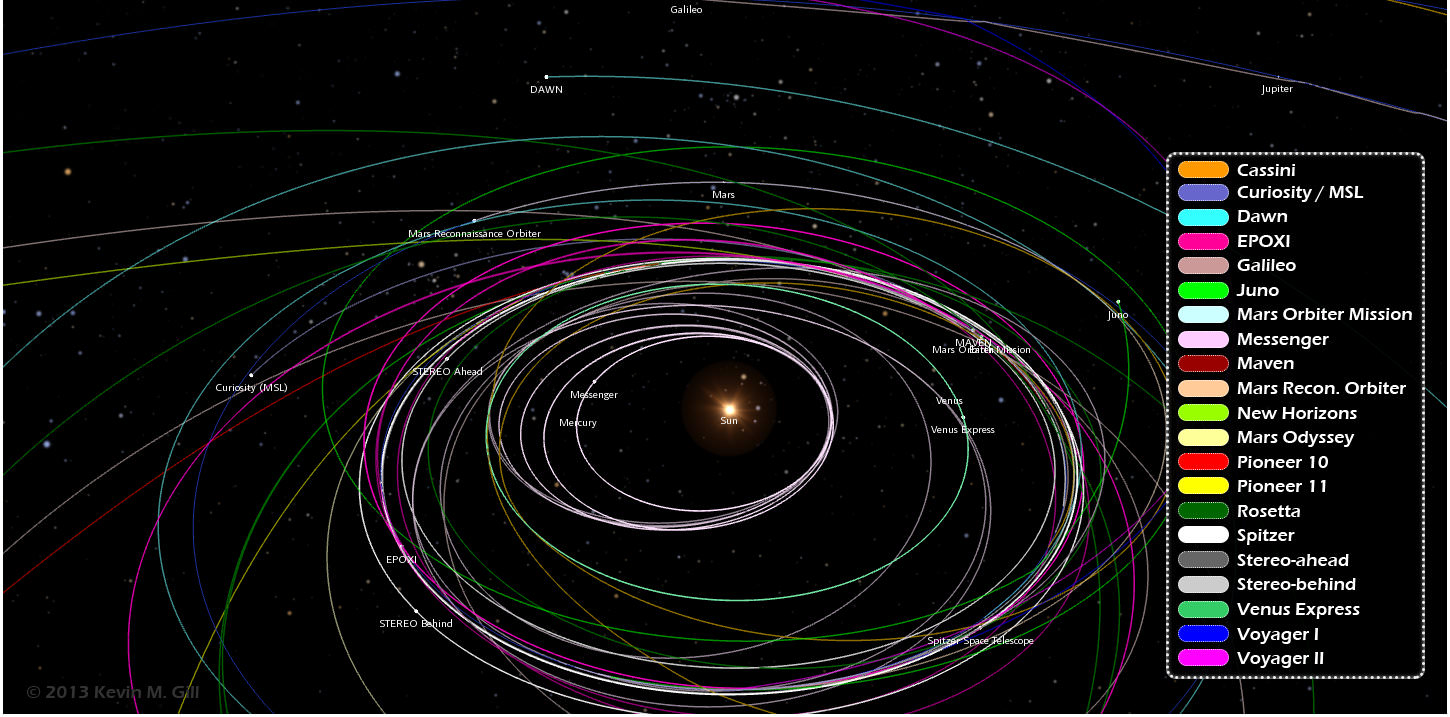
Want to know the orbital paths where different spacecraft have traveled and where they are now? A great new infographic put together by Kevin Gill is a visualization of where 21 different unmanned spacecraft have traveled through the Solar System. “The spacecraft data and planet orbital data is derived from NASA/JPL Horizons ephemeris,” said Gill on G+. “The image was rendered using a modified version of my Orbit Viewer WebGL application and put into infographic form using Photoshop. Body and spacecraft positions are as of December 15, 2013.”
By the way, Kevin’s orbit viewer is really fun to play with!
See the full infographic below or on Kevin’s website here:
Paths range from the earliest vector data available, typically just following launch, to either the latest data available or December 15, 2013, whichever is earlier.
“Originally intended as an animation, my browser was not too amused with the quantity of data being thrown at it,” Kevin said via G+. “In the new year, given sufficient demand, I may optimize the modeling and animation algorithms and either produce the animation or release it as a distinct WebGL visualization.”
We certainly look forward to that!
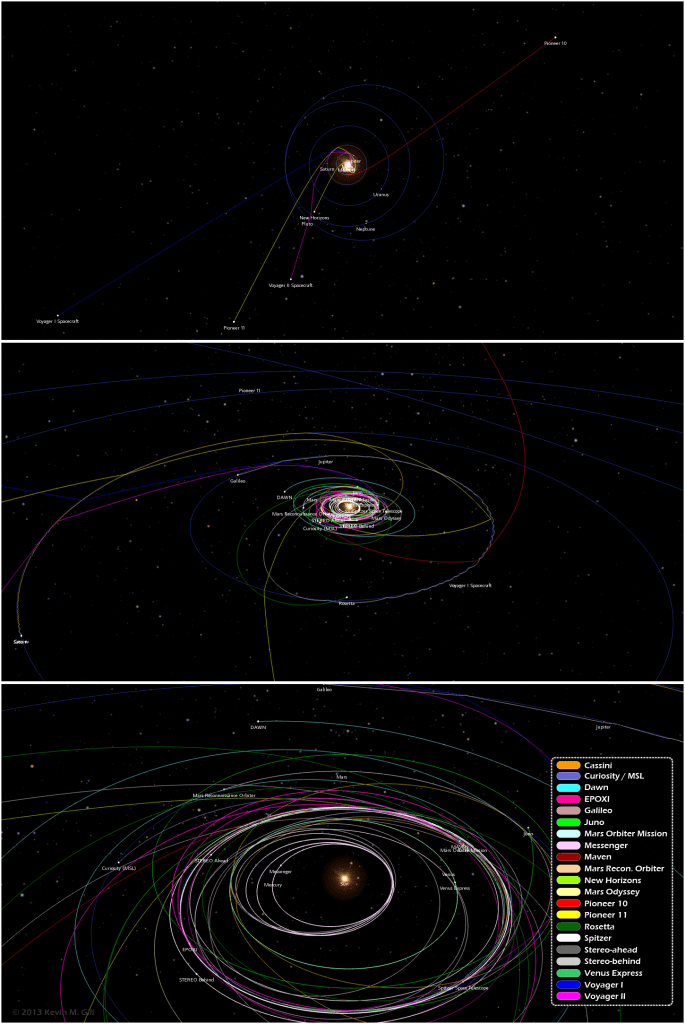
Tonight: The Rise of the 2013 “Mini-Moon”
The final Full Moon of 2013 occurs tonight, and along with it comes something special: the most distant and visually smallest Full Moon of 2013.
Why doesn’t the annual “mini-moon” receive the same fanfare and hype that the yearly perigee – or do you say Proxigean to be uber-obscure – “supermoon” does? The smallest Full Moon of the year does appear to have a public relations problem in this regard. But as you’ll see, the circumstances for this week’s Full Moon are no less fascinating.
The exact timing of tonight’s Full Moon occurs at 4:28 AM EST/9:28 Universal Time (UT) on Tuesday, December 17th. This occurs just two days and 14 hours prior to the Moon reaching apogee on December 19th at 6:50PM EST/23:50 UT at 406,267 kilometres distant. This is one of the three most distant apogees of 2013, and the closest to Full for the year. It’s also with 500 kilometres of the most distant apogee than can occur, as the Moon’s apogee can vary between ~404,000 and 406,700 kilometres distant.
Tonight’s Full Moon will have an apparent angular diameter of around 29.8’ arc minutes, just a shade lower than the usual value quoted of around half a degree or 30’. The visual size of the Moon as seen from the Earth varies about 12% from 34.1’ to 29.3’. Also, the Moon is also about half an Earth radius more distant when it’s on the local horizon versus at the zenith overhead!
This is also the closest Full Moon to the December solstice, which occurs four days later on Saturday, December 21st at 12:11 PM EST/17:11 UT. This marks the start of astronomical summer in the southern hemisphere and the beginning of the winter season in the north. Think of tonight’s Full Moon as a sort of “placeholder,” marking the point at which the Sun will occupy during the June solstice on the Gemini-Taurus border.
This all means that tonight’s Full Moon rides high for northern hemisphere residents towards local midnight. But the “Long Night’s Moon” of 2013 is rather lackluster in terms of declination. While it’s the northernmost Full Moon of 2013 at a declination of +18.7 degrees, it’s a far cry from the maximum declination of +28.72 degrees (the angle of the ecliptic plus the tilt of the Moon’s orbit) that it can achieve. This only occurs every 18.6 years and last occurred in 2006 and will happen again around 2025. We’re currently headed towards a shallow minimum for the Moon’s orbit in 2015. Ancient European and Native American cultures both knew of this cycle of high-flying moons.
Not weird enough? The next “most distant Full Moon of the Year” happens only one lunation later on January 16th… within just 2 hours of apogee! Perhaps January’s Full Moon is due notoriety as a “Super-Mini Moon?” Such a pairing of “mini-moons” last occurred on 2004-2005 and will next occur on 2021-2022.
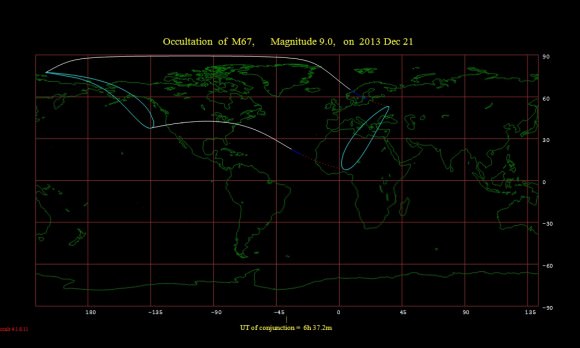
The Moon also visits some other celestial sights this week. After passing five degrees north of Jupiter on December 19th, the Moon heads towards an occultation of the open cluster M67 in the constellation Cancer on December 21st for northern North America. Though the Moon will be waning gibbous, it might just be possible to note the reappearance of the cluster on the Moon’s dark limb. Other occultations for the remainder of December by the Moon include an occultation of Spica on December 27th for northern Asia, Saturn on December 29th for Antarctica, and +3.6th magnitude star Lambda Geminorum for Canada on December 18th.
The passing of the Full Moon also means it will be entering into the morning sky, which also means bad news for viewers of the Ursid meteor shower which peaks on December 22nd and hunters of Comet C/2013 R1 Lovejoy, currently shining at +5th magnitude in the constellation Hercules low in the dawn.
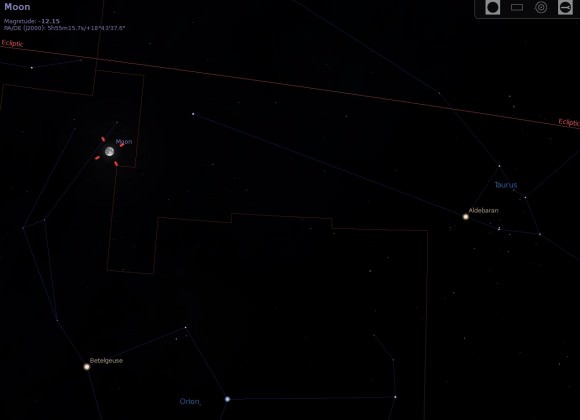
The keen-eyed may notice the Moon also transits through the northern end of the non-zodiacal constellation of Orion on Tuesday, December 17th. Did you know that the Moon can actually stray far enough away from the ecliptic to cross through 18 constellations? The Six non-zodiacal constellations it can transit are: Orion, Ophiuchus, Corvus, Sextans, Auriga and Cetus.
Other names for the December Full Moon include the Yule, Oak, and Cold Moon.
Finally, a new Earthly ambassador is now roaming the lunar surface.
China’s Chang’E-3 spacecraft landed on the Moon just outside of the Bay of Rainbows (Sinus Iridum) near Montes Recti in the northern section of the Mare Imbrium on Saturday, December 14th. The landing site is visible now on the lunar nearside, and can be seen with that new Christmas telescope you’ve been itching to try out. Look for the Sinus Iridum as a wide crescent scarp, a sort of “notch” in the top of Mare Imbrium:
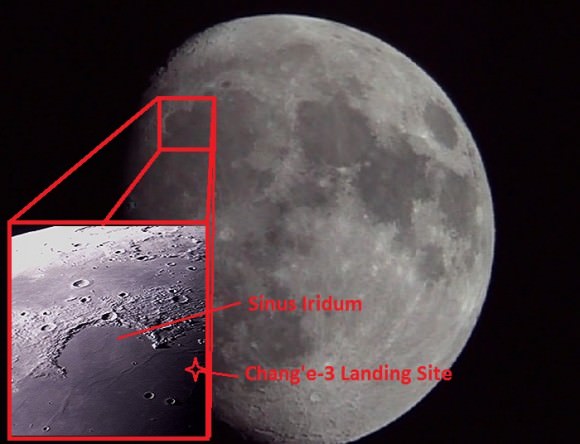
China’s Yutu or “Jade Rabbit” rover has been beaming back some splendid images of the lunar surface!
So don’t let the cold temperatures deter you from exploring the lunar surface, and the strange but fascinating motions of our nearest natural celestial neighbor. Dress warm and be sure this Christmas season to raise a glass of ye ole Nog to the Solstice/Yule Moon.
Can Stars Collide?
Imagine a really bad day. Perhaps you’re imagining a day where the Sun crashes into another star, destroying most of the Solar System.
No? Well then, even in your imagination things aren’t so bad… It’s all just matter of perspective.
Fortunately for us, we live in out the boring suburbs of the Milky Way. Out here, distances between stars are so vast that collisions are incredibly rare. There are places in the Milky Way where stars are crowded more densely, like globular clusters, and we get to see the aftermath of these collisions. These clusters are ancient spherical structures that can contain hundreds of thousands of stars, all of which formed together, shortly after the Big Bang.
Within one of these clusters, stars average about a light year apart, and at their core, they can get as close to one another as the radius of our Solar System. With all these stars buzzing around for billions of years, you can imagine they’ve gotten up to some serious mischief.
Within globular clusters there are these mysterious blue straggler stars. They’re large hot stars, and if they had formed with the rest of the cluster, they would have detonated as supernovae billions of years ago. So scientists figure that they must have formed recently.
How? Astronomers think they’re the result of a stellar collision. Perhaps a binary pair of stars merged, or maybe two stars smashed into one another.
Professor Mark Morris of the University of California at Los Angeles in the Department of Physics and Astronomy helps to explain this idea.
“When you see two stars colliding with each other, it depends on how fast they’re moving. If they’re moving at speeds like we see at the center of our galaxy, then the collision is extremely violent. If it’s a head-on collision, the stars get completely splashed to the far corners of the galaxy. If they’re merging at slower velocities than we see at our neck of the woods in our galaxy, then stars are more happy to merge with us and coalesce into one single, more massive object.”
There’s another place in the Milky Way where you’ve got a dense collection of stars, racing around at breakneck speeds… near the supermassive black hole at the center of the galaxy.
This monster black hole contains the mass of 4 million times the Sun, and dominates the region around the center of the Milky Way.
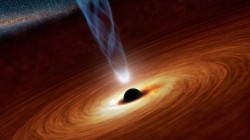
“The core of the Milky Way is one of those places where you find the extremes of nature. The density of stars there is higher than anywhere else in the galaxy,”Professor Morris continues. “Overall, in the center of our galaxy on scales of hundreds of light years, there is much more gas present than anywhere else in the galaxy. The magnetic field is stronger there than anywhere else in the galaxy, and it has it’s own geometry there. So it’s an unusual place, an energetic place, a violent place, because everything else is moving so much faster there than you see elsewhere.”
“We study the stars in the immediate vicinity of the black hole, and we find that there’s not as many stars as one might have expected, and one of the explanations for that is that stars collide with each other and either eliminate one another or merge, and two stars become one, and both of those processes are probably occurring.”
Stars whip around it, like comets dart around our Sun, and interactions are commonplace.
There’s another scenario that can crash stars together.
The Milky Way mostly has multiple star systems. Several stars can be orbiting a common center of gravity. Many are great distances, but some can have orbits tighter than the planets around our Sun.
When one star reaches the end of its life, expanding into a red giant, It can consume its binary partner. The consumed star then strips away 90% of the mass of the red giant, leaving behind a rapidly pulsating remnant.
What about when galaxies collide? That sounds like a recipe for mayhem.
Surprisingly, not so much.
“That’s actually a very interesting question, because if you imagine two galaxies colliding, you’d imagine that to be an exceptionally violent event,’ Professor Morris explains. “But in fact, the stars in those two galaxies are relatively unaffected. The number of stars that will collide when two galaxies collide is possibly counted on the fingers of one or two hands. Stars are so few and far between that they just aren’t going to meet each other with any significance in a field like that.”
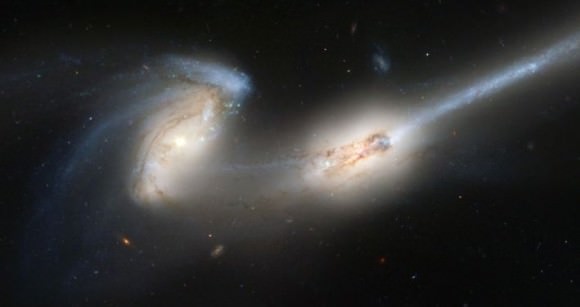
“What you see when you see two galaxies collide, however, on the large scale, is that the tidal forces of the two galaxies will rip each of the galaxies apart in terms of what it will look like. Streams of stars will be strewn out in various directions depending on the precise history of the interaction between the two galaxies. And so, eventually over time, the galaxies will merge, the whole configuration of stars will settle down into something that looks unlike either of the two initially colliding galaxies. Perhaps something more spheroidal or spherical, and it might look more like an elliptical galaxy than the spiral galaxy that these two galaxies now are.”
Currently, we’re on a collision course with the Andromeda Galaxy, and it’s expected we’ll smash into it in about 4 billion years. The gas and dust will collide and pile up, igniting an era of furious star formation. But the stars themselves? They’ll barely notice. The stars in the two galaxies will just streak past each other, like a swarm of angry bees.
Phew.
So, good news! When you’re imagining a worse day, you won’t have to worry about our Sun colliding with another star. We’re going to be safe and sound for billions of years. But if you live in a globular cluster or near the center of the galaxy, you might want to check out some property here in the burbs.
Thanks to Professor Mark Morris at UCLA – visit their Physics and Astronomy program homepage here.
Second Monkey Travels Safely To Space And Back, Iran Reports
Iran’s space program reportedly launched its second monkey into space on a 15-minute flight on Saturday (Dec. 14).
Reports from the Islamic Republic News Agency said the ballistic flight reached as high as 75 miles (120 kilometers). That’s just beyond the Karman line of 62 miles (100 kilometers) that many authorities cite as the boundary of space.
“The President said that thank God, Iranian astronauts launched into the space the second monkey, Fargam, on the first day of the Week of Research, the ‘Pajouhesh’ explorer and landed in full safety and health,” read a dispatch on IRNA, which is the official state agency in Iran.
The launch has not been verified outside of Iran. In January, the country announced the launch of a first monkey, Pishgam (which means “Pioneer” in Farsi).
The United States, Soviet Union and France sent primates themselves into space in the 1960s, many of which did not survive the trip. “Ham” is among the most famous monkey space voyagers; the U.S. chimp launched into space and landed safely on Jan. 31, 1961, a few months before astronaut Al Shepard became the first American person in space that May.
Thousands Of Supermassive Black Holes Could Lurk In New X-Ray Data
Supermassive black holes likely are behind most of the nearly 100,000 new X-ray sources plotted by the Swift X-ray Telescope, according to findings led by the University of Leicester in the United Kingdom. The results came from poring over eight years of data produced by the Swift space observatory.
“Stars and galaxies emit X-rays because the electrons in them move at extremely high speeds, either because they are very hot (over a million degrees) or because extreme magnetic fields accelerate them. The underlying cause is usually gravity; gas can be compressed and heated as it falls on to black holes, neutron stars and white dwarfs or when trapped in the turbulent magnetic fields of stars like our Sun,” the university stated.
“Most of the newly discovered X-ray sources are expected to signal the presence of super-massive black holes in the centers of large galaxies many millions of light-years from earth, but the catalog also contains transient objects (short-lived bursts of X-ray emission) which may come from stellar flares or supernovae.”
The results were published in The Astrophysical Journal, which you can read here. You can also read the prepublished version on Arxiv.
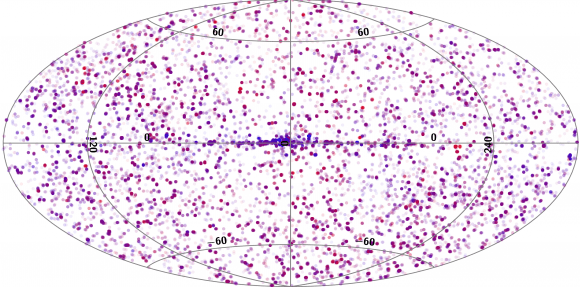
Evans (University of Leicester)
Virtual Star Party – December 15, 2013 – Blazing Moon, Beautiful Nebulae
Hosts: Fraser Cain and Scott Lewis
Astronomers: David Dickinson, Gary Gonella, Mark Behrendt, Roy Salisbury, Tom Nathe, Stuart Foreman
Continue reading “Virtual Star Party – December 15, 2013 – Blazing Moon, Beautiful Nebulae”
Chinese rover & lander beam back Portraits with China’s Flag shining on Moon’s Surface

Yutu rover emblazoned with Chinese Flag as seen by the Chang’e-3 lander on the moon on Dec. 15, 2013. Notice the rover tire tracks left behind in the loose lunar topsoil. Credit: China Space
Story updated[/caption]
China’s ambitious lunar space exploration program achieved another stunning success Sunday night, Dec 15, when the countries inaugural Chang’e-3 lunar lander and rover beamed back portraits of one another snapped from the Moon’s surface – that also proudly displayed the brilliant red Chinese national flag shining atop an extraterrestrial body for the very first time in human history.
“I announce the complete success of the Chang’e-3 mission,” said Ma Xingrui, chief commander of China’s lunar program, during a live CCTV broadcast as the portraits were shown to a worldwide audience from huge screens mounted at the mission control at the Beijing Aerospace Control Center (BACC) in Beijing.
Chinese President Xi Jinping was on hand to personally witness the momentous events in real time.
A wave of cheers and high fives rocked around mission control as the startling imagery of the ‘Yutu’ rover and Chang’e-3 lander nestled atop the Moon’s soil in the Bay of Rainbows was received around 11:42 p.m. Sunday, local Beijing time, 10:42 a.m. EST, via China’s own deep space tracking network.
Xi Jinping’s presence was a clear demonstration of China’s confidence in its lunar team and the importance of this space spectacular to China’s prestige and technological prowess.
China thus became only the 3rd country in the world to successfully soft land a spacecraft on Earth’s nearest neighbor after the United States and the Soviet Union.
China’s ‘Yutu’ rover had just rolled majestically onto the Moon’s soil hours earlier on Sunday, Dec. 15, at 4:35 a.m. Beijing local time – barely seven hours after the Chang’e-3 mothership touched down atop the lava filled plains of the Bay of Rainbows on Dec. 14.
The rover’s wheels left behind noticeable tire tracks as it drove across the loose lunar topsoil.
Read my earlier detailed accounts of the Dec. 15 drive by Yutu onto the lunar surface illustrated with an extensive photo gallery – here; and of the stunning Dec. 14 landing – here.
CCTV showed China’s President gleefully shaking hands and extending congratulations with many members of the mission team at BACC after seeing the high resolution photos of the Chang’e-3 rover emblazoned with China’s flag for himself.
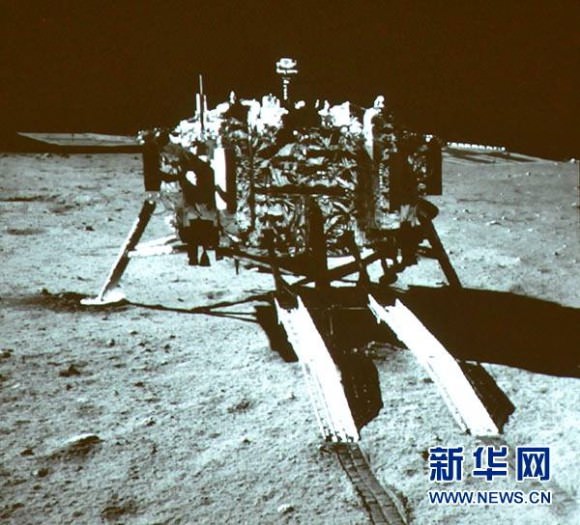
It’s been nearly four decades since the prior lunar landing was accomplished by the Soviet Union’s Luna 24 sample return spacecraft back in 1976.
America’s last visit to the Moon’s surface occurred with the manned Apollo 17 landing mission – crewed by astronauts Gene Cernan and Harrison ‘Jack’ Schmitt , who coincidentally ascended from the lunar soil on Dec. 14, 1972 – exactly 41 years ago.
“The Central Committee of the Communist Party and the Central Military Commission [responsible for China’s space program] sends congratulations to all the staff that participated in the successful completion of the mission and China’s first soft landing on the moon,” said the Chinese vice premier Ma Kai during the CCTV broadcast.
“The rover and lander are working properly and reaching the goals set.”
“Chang’e-3 is China’s most complicated space mission,” said Kai. “This shows China is dedicated to the peaceful uses of space.”
“There are many more complicated and difficult tasks ahead.”
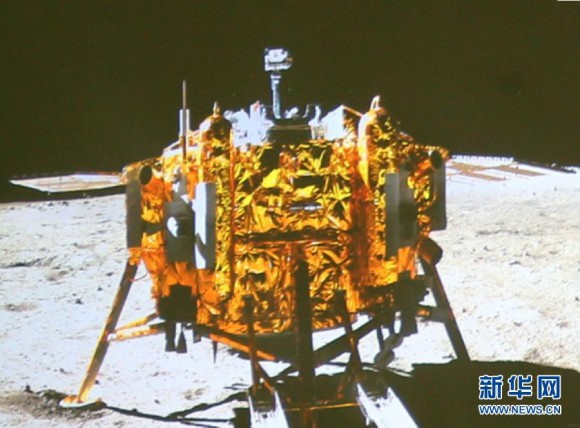
Indeed so far the Chang’e-3 mission has been primarily a highly successful demonstration of the extremely challenging engineering required to accomplish China’s first lunar landing.
Now the science phase can truly begin.
Over 4600 images have already been transmitted by Chang’e-3 since the Dec. 14 touchdown.
After rolling all six wheels into the dirt, Yutu – which translates as Jade Rabbit – drove to a location about nine meters north of the lander, according to CCTV commentators.
The rover then turned around so that the red Chinese flag emblazoned on the front side would be facing the lander’s high resolution color cameras for the eagerly awaited portraits of one another.
Yutu is nearly the size of a golf cart. It measures about 1.5 m x 1 m on its sides and stands about 1.5 m (nearly 5 feet) tall – nearly human height.
The 120 kg Yutu rover will now begin driving in a circle around the right side of the 1200 kg Chang’e-3 lander – for better illumination – at a distance ranging from 10 to 18 meters.
The rover will snap further photos of the lander as it traverses about from 5 specific locations – showing the front, side and back – over the course of the next 24 hours.
See the accompanying graphic – written in Chinese.
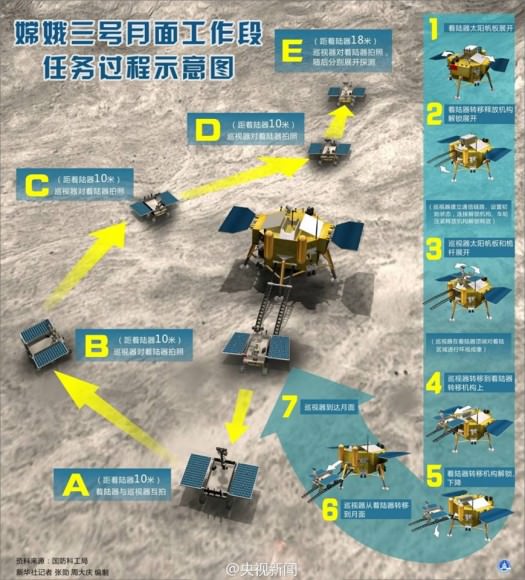
Thereafter Yutu will depart the landing site forever and begin its own lunar trek that’s expected to last at least 3 months.
So the rover and lander will soon be operating independently.
They are equipped with eight science instruments including multiple cameras, spectrometers, an optical telescope, ground penetrating radar and other sensors to investigate the lunar surface and composition.
The radar instrument installed at the bottom of the rover can penetrate 100 meters deep below the surface to study the Moon’s structure and composition in unprecedented detail, according to Ouyang Ziyuan, senior advisor of China’s lunar probe project, in an interview on CCTV.
A UV camera will study the earth and its interaction with solar wind and a telescope will study celestial objects. This is done during the lunar day.
It will also investigate the moon’s natural resources for use by potential future Chinese astronauts.
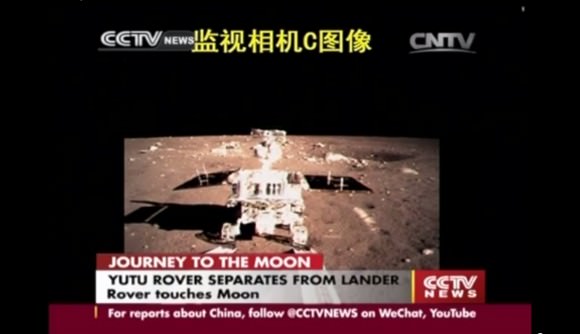
The two probes are now almost fully operational. Most of the science instruments are working including at least three cameras and the ground penetrating radar.
And although they have survived the harsh lunar environment thus far, they still face massive challenges. They must prove that they can survive the extremely cold lunar night and temperature fluctuations of more than 300 degrees Celsius – a great engineering challenge.
The rover will hibernate during the two week long lunar night.
A radioisotopic heater will provide heat to safeguard the rovers computer and electronics – including the alpha particle X-ray instrument on the rover’s robotic arm.
The Bay of Rainbows, or Sinus Iridum region, is located in the upper left portion of the moon as seen from Earth. You can see the landing site with your own eyes.
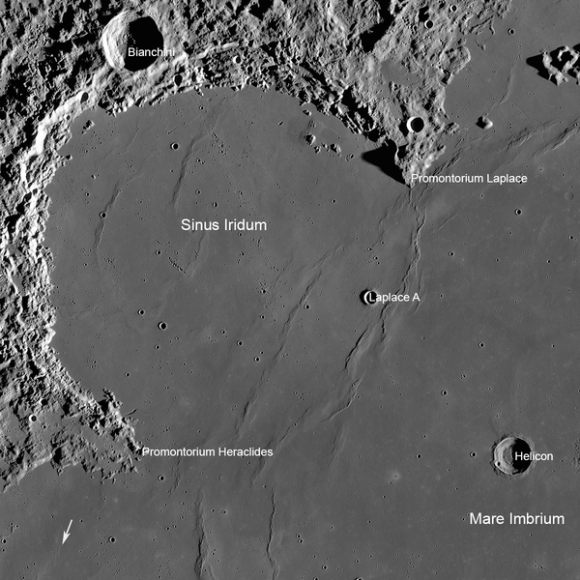
It was imaged in high resolution by China’s prior lunar mission – the Chang’e-2 lunar orbiter and is shown in graphics herein.
China’s Chang’e-3 probe joins NASA’s newly arrived LADEE lunar probe which entered lunar orbit on Oct. 6 following a spectacular night time blastoff from NASA’s Wallops Flight Facility in Virginia.
Stay tuned here for Ken’s continuing Chang’e-3, LADEE, MAVEN, MOM, Mars rover and more news.
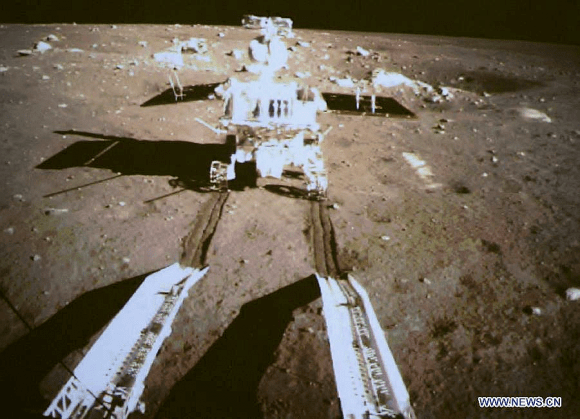
China’s Maiden Lunar Rover ‘Yutu’ Rolls 6 Wheels onto the Moon – Photo and Video Gallery
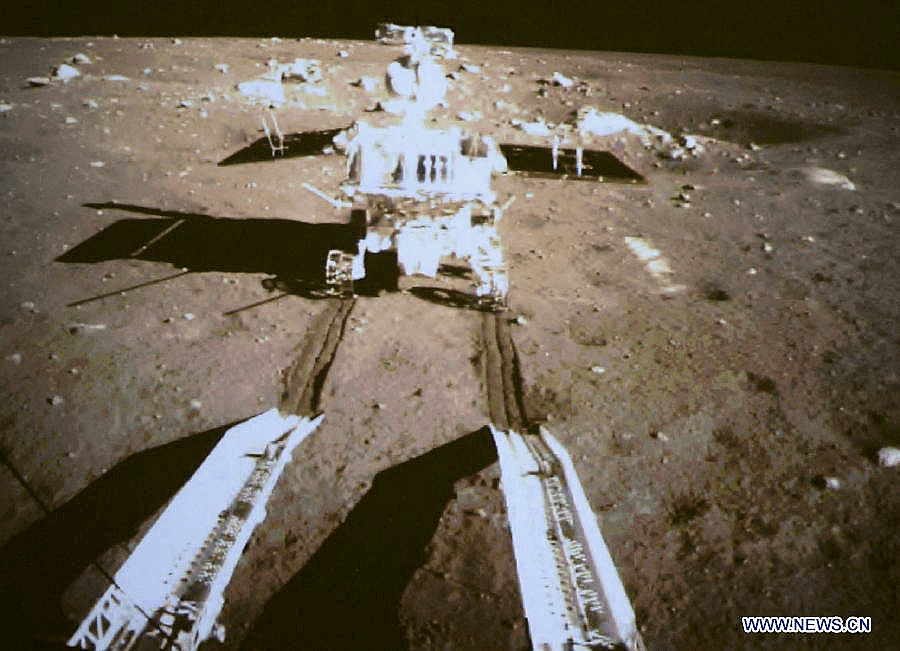
China’s first lunar rover separates from Chang’e-3 moon lander early Dec. 15, 2013. Screenshot taken from the screen of the Beijing Aerospace Control Center in Beijing. Credit: Xinhua/post processing by Marco Di Lorenzo/Ken Kremer
Updated- See below Photo Gallery of Yutu’s descent to lunar surface on Dec. 15, 2013[/caption]
China’s first ever lunar rover rolled majestically onto the Moon’s soil on Sunday, Dec. 15, barely seven hours after the Chang’e-3 mothership touched down atop the lava filled plains of the Bay of Rainbows.
Check out the gallery of stunning photos and videos herein from China’s newest space spectacular atop stark lunar terrain.
The six wheeled ‘Yutu’, or Jade Rabbit, rover drove straight off a pair of ramps at 4:35 a.m. Beijing local time and sped right into the history books as it left a noticeably deep pair of tire tracks behind in the loose lunar dirt.

The stunning feat was broadcast on China’s state run CCTV using images transmitted to Earth from cameras mounted on the Chang’e-3 lander and aimed directly at the rear of the departing moon buggy.
Watch this YouTube video from CCTV showing the separation of ‘Yutu’ from the lander:
The scene was reminiscent of NASA’s Mars Sojourner rover driving of the Mars Pathfinder lander back in 1997.
Chinese space engineers based at the Beijing Aerospace Control Center (BACC) carefully extended a pair of ramps out from the lander in a complex process, drove Yutu onto the ramps and then gently lowered them onto the moon’s soil.
China’s Change’-3 mission had just safely soft landed on the Moon hours only earlier on Saturday, Dec. 14 at 9:11 p.m. Beijing time, 8:11 EST at the Sinus Iridum region, or Bay of Rainbows.
China thus became only the 3rd country in the world to successfully land a spacecraft on Earth’s nearest neighbor after the United States and the Soviet Union.
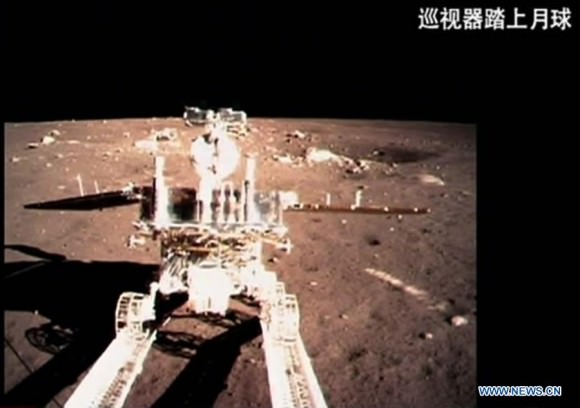
It’s been nearly four decades since the prior lunar landing was accomplished by the Soviet Union’s Luna 24 sample return spacecraft.
Read my detailed account of the Chang’e-3 landing on Dec. 14 – here.
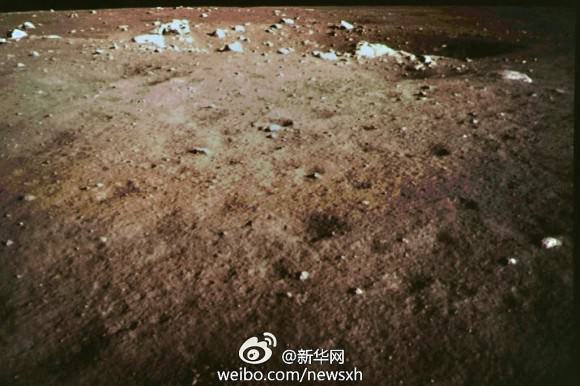
Watch this YouTube video compilation of CCTV’s Dec. 14 landing coverage:
Over 4600 images have already been transmitted by Chang’e-3 in less than a day on the Moon.
Tomorrow, the 120 kg Yutu rover will begin driving in a circle around the 1200 kg lander.
And the pair of lunar explorers will snap eagerly awaited portraits of one another!
The rover and lander are equipped with 8 science instruments multiple cameras, spectrometers, an optical telescope, ground penetrating radar and other sensors to investigate the lunar surface and composition.
The radar instrument installed at the bottom of the rover can penetrate 100 meters deep below the surface to study the Moon’s structure and composition in unprecedented detail, according to Ouyang Ziyuan, senior advisor of China’s lunar probe project, in an interview on CCTV.
China’s Chang’e-3 probe joins NASA’s newly arrived LADEE lunar probe which entered lunar orbit on Oct. 6 following a spectacular night time blastoff from NASA’s Wallops Flight Facility in Virginia.
Stay tuned here for Ken’s continuing Chang’e-3, LADEE, MAVEN, MOM, Mars rover and more news.
